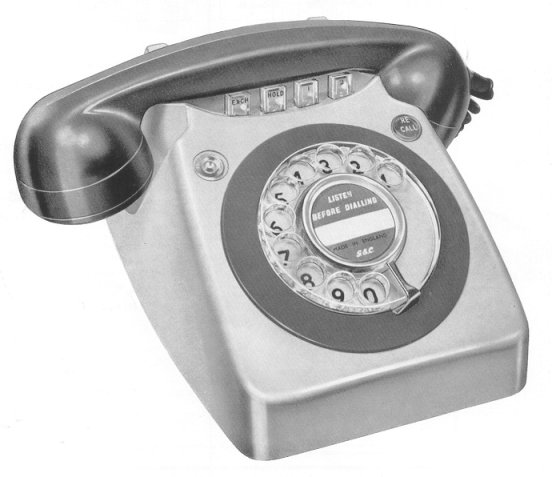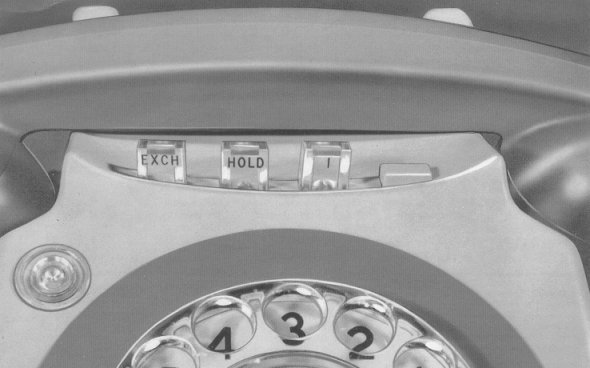GEC 740
1/2 and 1/3 Switching Telephone

Two or three telephones on one exchange line
The GEC740 switching telephone is used to provide independent access to a
single exchange line from two telephones ('1+2' system) or three telephones ('1+3'
system); the user simply lifts the handset and presses an EXCHANGE button on the telephone
(warning lamps light to show when the line is in use). A single telephone type is used for
all positions in either system. Typically, a system could be provided for a secretary, to
filter incoming calls, and one or two executives.
Also provides an intercom system
It is also an intercom between any of the telephones. The telephones can be used for
intercommunication while an exchange call is 'held' (exchange and intercom calls are
secret from each other).
Pushbutton switching between telephones
System operation is controlled by four pushbutton switches in front of the handset on
each telephone. Each is clearly marked to indicate its function.

Incoming calls ring all bells
An incoming call rings the bell at each telephone in the system.
A bell-loudness control on each telephone is operated by a lever which protrudes from
under the front of the telephone. Executives can also switch off the bells in their
telephones if required - the secretary cannot.
A secretary can deal with all calls
A secretary can answer all incoming calls and transfer them to the executive as
required. She can also dial all the executive's outgoing calls if he wishes, although he
can make his own calls without reference to his secretary.
Standard instrument adopted on site to meet particular needs
Only one version of the basic GEC740 telephone is needed - this simplifies store
keeping and spares - the telephones are supplied ready for immediate interconnection as a
'1+2' system. Any adaption to meet particular needs is carried out easily and quickly on
site by the installation engineer. For example, an extra switch mechanism is always fitted
but with its operating button blanked off: this mechanism can be used to extend the system
to a '1+3' system (a clear plastic button, suitably marked, is supplied with each
telephone for this purpose). The system may be installed initially with the three
telephones or the third may be added at any later date - in which case no extra parts have
to be ordered for the other two.
Operator recall can be provided
Alternatively, the spare mechanism can be used to provide operator recall on PABX
systems (an alternative suitably marked button is supplied with each telephone). When a '1+3' system requires operator recall, a separate pushbutton switch is mounted in the
telephone on the opposite side of the dial to the warning lamp as shown in the
illustration.
Executives calls are secret
The system provides priority between the telephones for access to the exchange line.
Thus when an executive is using the exchange line, the secretary cannot gain access to it;
this ensures that executives' conversations cannot be overheard. If required, this feature
can be removed by a simple alteration to the telephone terminal strapping during
installation.

Optional facilities
Pushbutton telephones
The telephone is normally supplied with a rotary dial, operating
at 10 IPS, but can be supplied with a pushbutton keyset. Two versions are available: one
provides loop disconnect (decadic) signalling, imputing at either 10 or 20 IPS, and the
other provides DC leg signalling for use on suitable PABX systems.
Loudspeaking telephones
GEC loudspeaking telephones LST4D, fitted with the appropriate
switches etc., are available for executives who prefer hands-free operation of their
telephones.
Visual and delayed ringing
An 'add-on' unit provides visual indication of exchange
ringing. The exchange lamps are made to flash in synchronism with the ringing signal. In
addition, the lamps will flash at about twice per second when an exchange call is being
held so that the users can discriminate between the 'line in use' and 'caller waiting'
conditions. The add-on unit also automatically transfers the ringing signal to the
executive telephones if the secretary does not answer her telephone within a predetermined
time, adjustable up to 15 seconds. This unit replaces the 'bell off' facility for
executive's telephones.
Abridged Specification
The GEC740 switching telephone is a GEC746 instrument to which has been added the
necessary switches, lamp, and DC buzzer to provide the operational features. Each
telephone is supplied with four switch mechanisms and three operating buttons (EXCHANGE,
HOLD, CALL 1 ). Two additional buttons are stored within the case so that, in conjunction
with the spare mechanism, the telephone can be adapted for use as '1+3' or '1+2 + recall'
systems on site by a telephone engineer. An additional pushbutton switch is required, and
can be installed on site, to provide a '1+3 + recall' system.
Exterior
Case and handset moulded in ABS high-impact plastic, dual grey (the handset, cords and
dial surround are the darker tone). Black and ivory telephones available to special order.
The case can be removed without disturbing the switch mechanisms, or their interlocking
with the cradle switch - only the operating buttons are retained by the case.
Cords
PVC-covered cadmium-tinsel-conductor cords. Held in position by grommets which relieve
conductors of any stresses.
Line cord, straight: 1830 mm (72 in)
Handset cord, coiled: 250 mm (10 in) unextended; 1700 mm (68 in) extended.
Cradle switch
Sealed microswitches.
Dial
Characters printed black on antique-silver background beneath clear plastic finger plate.
Trigger type and self-compensating action. Projects through self-centring ring on case. No
appreciable variations in pulse ratio after 4.5million impulses.
Speed: 10 IPS (20 IPS version available).
Inter-digit pause: 240 ms minimum.
Break-to-make ratio: 2 to 1 (other ratios can be supplied).
Transducers
Receiver inset: Rocking armature, replaceable capsule; sensitivity, +46 dB relative to 1
dyne/cm squared/MW available power.
Transmitter inset: Carbon granule, replaceable capsule; sensitivity +30 dB relative to 1
mV/dyne/cm squared at 20 dynes/squared input.
Regulator
An automatic volume regulator is fitted to limit speech-signal amplitudes on lines shorter
than 400 ohm; introduces virtually no attenuation on longer lines.
Signalling
Exchange: double-coil ringer; DC resistance 1000 ohms; accepts ringing currents between 16
and 30 Hz; bells, double gong, harmonising tones; 3-position volume control with optional
'bell off' position. Intercommunication.- DC single-coil buzzer, moving armature type; DC
resistance 55 A signal lamp is fitted to each telephone to indicate when the exchange line
is in use.
Power supply
10v to 12v DC to operate buzzers, lamps, and intercommunication circuits. This can be
provided either by a GEC power unit or 12v DC dry batteries. In the event of a mains
supply failure, the exchange line remains in service, but lamp and buzzer indications and
the intercom circuit are inoperative.
Choke/capacitor unit
A choke/capacitor unit is required for each system to provide isolation between the
exchange line and the DC feed for the intercom circuit. The unit can be either wall or
floor mounted and is approximately 100 mm x 65 mm (4 in x 2.5 in) with a dark-grey moulded
cover.
Environment Suitable for use in tropical climates.
Protected against entry of insects.
Dimensions and Weight
complete telephone: height, 119 mm (4.75 in)
width, 250 mm (10 in) over handset; 140 mm (5.5 in) over case
depth, 216 mm (8.5 in) over case
Telephone
weight, 1.6 kg (3.5 lb)
Handset: 240 g (8.5 oz).
Catalogue Numbers
A complete system requires:
Two or three GEC740 telephones type 98571 /BC-1.
One choke/capacitor unit type 98569N C.
One DC supply: either 12 V DC battery or GEC power unit type 97206T (200-250V AC input) or
type 97491T (100-125V AC input).
Installation instructions type CIR 135.
 GEC 740
GEC 740

